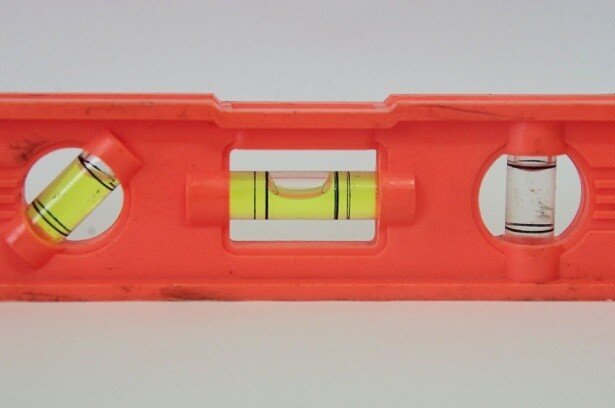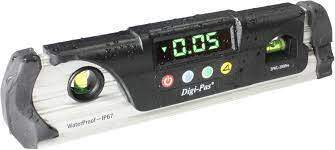As a professional who’s been in the renovation business for over 20 years, I’ve seen all kinds of changes in tools and technology. One of the handiest innovations I’ve adopted is the digital level.
A Digital level is an electronic instrument that contains a precision gravity sensor to determine orientation relative to level or plumb. This means that a digital level can measure whether a surface is level or the angle to level.
These high-tech devices have left old-fashioned spirit levels in the dust. In this article, I’ll explain what digital levels are, how they work, the different types available, and why they’re so useful for construction and home projects.
Contents
Now That We Know What A Digital Level Is, Let’s See How They Work
While digital levels may outwardly look similar to old-fashioned spirit levels, the internal technology is far more advanced. Instead of relying on the basic mechanics of a floating bubble, digital levels use a combination of sensors, accelerometers, and microprocessors to make extremely precise angle measurements.
- The key sensors inside digital levels are tilt sensors, which detect the precise angle of inclination in multiple axes. There are a few common types:
- Pendulum tilt sensors use a hanging pendulum attached to an electrical conduit. As the sensor tilts, the pendulum swings and contacts the sides of the conduit, completing electrical circuits that detect the direction and angle of tilt.
- Electrolytic tilt sensors contain two conductive liquids of different density separated by a barrier. When tilted, the conductive fluids flow and change the electrical resistance between electrodes in a predictable way based on the angle.
- Force collector tilt sensors use springs attached to an electrode post to measure force. The force increases with greater tilt angle as more springs compress. This force change is measured and converted into an angle value.
- In addition to tilt sensors, most digital levels also contain accelerometers to detect angular acceleration forces caused by movement and vibration.
- The data from both the tilt sensors and accelerometers is sent to a microprocessor where custom algorithms analyze and process the raw sensor readings. The algorithms apply temperature compensation and filtering to isolate the static gravity vector and precisely calculate the true angle relative to earth’s gravity.
- The microprocessor then displays the tilt angle on the digital display, lights LEDs to indicate level, or transmits the data wirelessly via Bluetooth or WiFi. The measurement resolution is far greater than a bubble level, often down to 0.05 degree increments or finer.
- Digital levels also include settings to change the units of measurement (degrees, percent slope, mm/m) and apply user calibration to set a custom zero point or plumb orientation.
The combination of precision tilt sensors, accelerometers, advanced data processing, and clear digital output enables digital levels to measure angles with incredible speed and accuracy compared to old simple spirit levels. This technical sophistication makes digital levels indispensable modern tool

Digital Level Advantages
After using my first digital level on a deck project a few years back, I was amazed by how much easier and more accurate it was compared to my old spirit level. Here are some of the biggest advantages I’ve found:
- Extremely precise measurements – Down to 0.05 degrees or better in many models
- Clear digital display – Easy to see and interpret the measurements
- Wireless connectivity – Bluetooth allows monitoring from a distance
- Data tracking – Angles can be recorded and tracked over time
- Digital calibration – Set your own zero point and measurement units
- Durable construction – Made to withstand job site conditions
These high-tech features really make a difference when doing precision work. I recently used my digital level when installing custom cabinetry in my own kitchen remodel. Being able to fine-tune each cabinet and get them perfectly level made the installation go much smoother.
Types of Digital Levels
Just like traditional spirit levels, digital levels come in a few basic styles:
Box Levels
- Short and compact, around 6-12 inches long
- Good for smaller jobs or checking level on objects
- Often have vial bubble as backup
Torpedo Levels
- Longer shape, 24-48 inches long
- Designed to reach across larger surfaces
- Great for walls, countertops, railings
Rotary Laser Levels
- Projects a laser plane across 360 degrees
- Allows layout of level lines over large area
- Self-levels electronically
- Useful for concrete work, room additions, grading
Line Laser Levels
- Projects a laser line for straight & level layout
- Single horizontal line, or multiple lines at 90° angles
- Ideal for wall layout, installing cabinets, tile, etc.

Construction Applications
I’ve found my digital levels indispensable for all kinds of construction and home renovation projects. Here are some of my most common uses:
- Framing – Leveling floors, walls, ceilings, trusses
- Tiling – Layout for floor and wall tile
- Cabinetry – Installing and leveling kitchen or bathroom cabinets
- Concrete work – Leveling forms before pouring
- Grading – Checking grades and drainage around foundations
- Finish carpentry – Hanging doors, installing trim
- Plumbing – Proper drainage for sink/tub/shower drains -Aligning machinery – Leveling pumps, conveyors, presses
I could go on and on with more examples. Bottom line – I reach for my digital level all the time to improve my work and make projects go smoother.
Why I Can’t Work Without Digital Levels
After years of using both traditional and digital levels, I’m fully convinced that the newer digital tools are far superior:
- They make precision work much easier – I can level items to within 0.1 degree consistently.
- The instant digital feedback lets me adjust until the reading is perfect. No more guesswork trying to center a bubble.
- Features like laser lines allow accurate layout even when working alone.
- Wireless connectivity means I can monitor levels from across the room.
- Data recording helps diagnose settling issues over time.
- They’ve made me faster, more efficient, and able to take on more precision projects. My customers are always impressed with the results.
While they require a higher initial investment, digital levels will easily pay for themselves with the time savings and enhanced quality they provide. I plan to steadily grow my digital tool collection.
Conclusion
In summary, digital levels represent a giant leap forward from traditional spirit levels. By utilizing digital sensors, processors, and user-friendly displays, they allow extremely precise angle measurements for all kinds of construction and home projects.
I’ve found them invaluable for cabinetry, tiling, concrete work, and much more. While they don’t completely replace the trusty old bubble levels, which still serve a purpose in rough work, digital levels are now indispensable tools for any contractor who does precision installation or alignment.
If you want to increase your accuracy and get flawlessly level surfaces, it’s definitely time to upgrade to the digital world.
Frequently Asked Questions
Q: How accurate are digital levels compared to spirit levels?
A: Digital levels are dramatically more accurate, measuring to 0.1 degree or finer, compared to 1-2 degrees for the best spirit levels. This allows for extremely precise level and plumb work.
Q: Can digital levels be used in place of laser levels for job site layout?
A: Yes, many digital line laser and rotary laser levels can project lines and planes for layout tasks. They provide similar functionality as dedicated laser levels.
Q: What should I look for when choosing a digital level?
A: Key factors are measurement resolution, battery life, durability, display quality, connectivity options, and warranty/service plan. Consider what features are most important for your intended uses.
Q: How durable are digital levels?
A: Quality digital levels are built to withstand dust, moisture, drops, and heavy use on contracting jobsites. Look for at least an IP54 dust/water resistance rating and a durable case.
Q: Do digital levels require calibration or routine maintenance?
A: Most digital levels never need recalibration in normal use. Follow the manual to reset to factory calibration if needed. Keep sensors clean and avoid hard impacts. Battery changes may be needed every 1-2 years.



